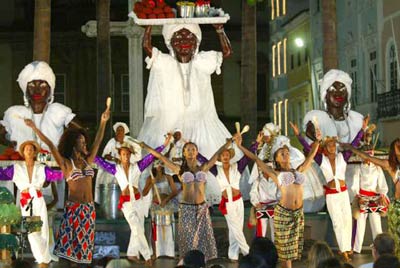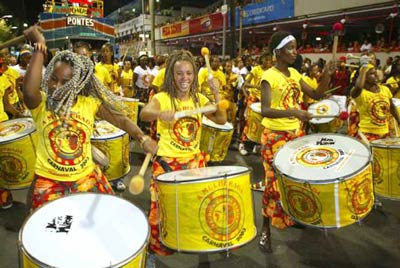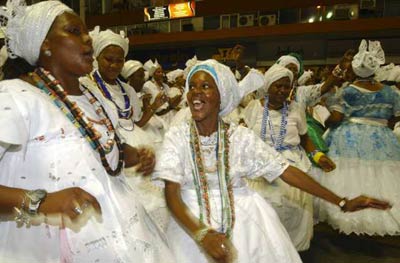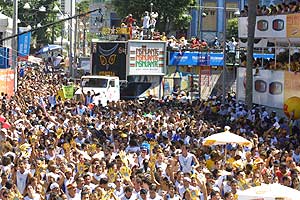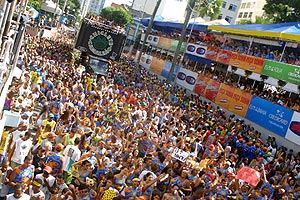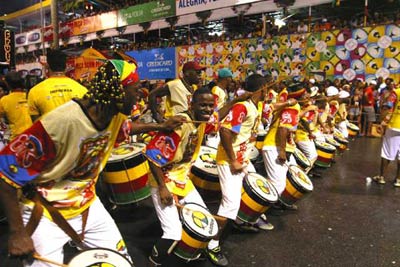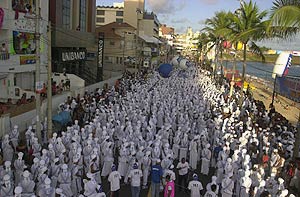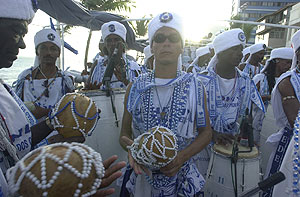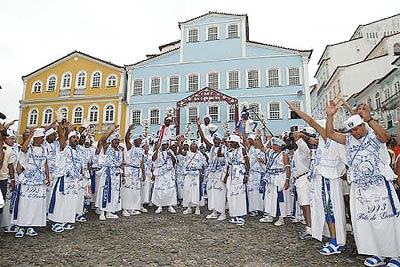 Carnival
in Bahia
Carnival
in Bahia
© JB Online
March 2003 - Opening
of the carnival in Salvador, BA,
at the Pelourinho, historical center of Salvador
Bahia,
land of rich and diversified cultural traditions, has one of
Brazil's happiest carnival celebrations. The festivities begin
on a Friday, when the famous "Rei Momo" (King Momo),
a typical character of the Brazilian carnival, receives in a
public square the symbolical keys of the city.
A
large number of tourists from many cities of Brazil and other
countries are attracted to the capital of the state, Salvador.
Over 140 organized carnival groups, known as "blocos"
spread themselves on the streets of Salvador during carnival.
© JB Online
March 2003 - Bloco
"Mulheradas" in Salvador, BA
© JB Online
March 2003 - "Bloco
das Baianas" in Salvador, BA |
© O Estadão
Trio Elétrico
in Bahia |
Salvador
is the home of the famous "trios elétricos"
(electric trios, if translated literally), a kind of music float.
Brazilian singers and groups perform at the top of a truck with
musicians and speakers in the streets of Salvador. |
|
The
"trios elétricos" were created in the 50s by
the musicians Dodô (Adolfo Nascimento) and Osmar (Osmar
Macedo). At first, the "trio elétrico" was called
"electric pair" (because it was formed only by Dodô
and Osmar). After another musician, Temístocles Aragão,
joined the pair, it began to be called "trio elétrico".
The
first "trio elétrico" went out the Salvador
streets in 1950 . It was an old Ford T, released in 1929, with
two speakers on top. The car's owner, Osmar Macedo, and his friend
Adolfo do Nascimento, nicknamed Dodô, decided to play "frevos"
(a musical style created in Pernambuco) using their electrified
guitars and amplifiers. Soon, they had invented a new way of
celebrating carnival and achieved success with the people following
them and dancing on the streets. Local businesses began to sponsor
the "trio elétricos", and these groups of musicians
playing on the back of a truck became extremely popular.
Dodô
and Osmar achieved a huge popularity and soon the old car was
replaced by a van and became known as "Trio Elétrico
de Dodô e Osmar". In 1952, they were given a truck.
Along the next years, other trios were created in Bahia and the
carnival trucks turned into a sort of trade mark to the local
parties.
Today,
the "trios elétricos" play every musical genre,
from reggae to classical in modern instruments. They entertain
carnival balls, provide musical background to political conventions
etc. They became a fantastic machine of sound and light, capable
of dragging a multitude of up to 20.000 people. |
|
The
trios carry 27 tons of sound equipment. The sophisticated ones
have 230 speakers, 32 horns, 80 tweeters, 54 amplifiers and two
computers to guarantee the musical instruments' tone and the
appropriate volume. The whole system may have 30,000 Watts and
may send the sound to three miles. In addition, it has a fantastic
light system, with over 12 light cannons and 900 color lamps. |
© Portal Terra
Salvador - March,
3 2003 - Trio Bloco Coruja |
|
Some
famous "trios elétricos" in Bahia are the Tapajós,
created in 1959, the Marajós, the Tupinambás, the
Saborosa, the Ypiranga and the Cinco Irmãos. All these
trios gather thousands of people during carnival in Bahia, driving
the crowd crazy with their frantic rhythm.
Other mini trios, connected to
"blocos" (group of people who parade on the streets)
were created later. These "blocos" that are followed
by the "trios elétricos" are called "blocos
de trio". |
© Portal Terra
Salvador - March,
3 2003 - Trio Bloco Camaleão |
These
mini trios are like stages installed on top of the trucks, with
an excellent quality of sound, lights and effects. The most famous
are the "blocos" Eva, Trás os Montes, Cheiro
de Amor, Camaleão and Pinel. Decorated trucks
that can cost up to half a million dollars now parade everywhere,
up and down the hills of the city with the musicians on top,
followed by hundreds of thousands of people. |
Carnival
in Bahia is famous not only for the "trios elétricos"
or the "blocos de trio", but also to the force of other
cultural street manifestations like the "afoxés"
and the "blocos Afro". They value the African culture
and honor their "mother Africa". Culturally, these
"blocos" represent the vital force of the black people
from Bahia.
The
"blocos" Afros emerged during Brazil's transition to
democracy in the mid 70s that facilitated the creation of black
political organizations. The most famous "blocos" Afros
are the Ilê Aiyê (the first "bloco" Afro,
established in 1974), Malê Debalê, Araketu, ObáLaiyê,
Puxada Carnavalesca Axé and Olodum.
Olodum
achieved international popularity with the recording of Paul
simon's CD "The Rhythm of the Saints".
© JB Online
March 2003 - Bloco
Olodum |
|
The
"afoxés" are important artistic expressions
in Bahia's cultural life and they are the oldest black organizations
to perform in Bahia's Carnival, dating to the end of the nineteenth
century. |
© Portal Terra
Salvador - March,
3 2003 - Afoxé Filhos de Gandhi |
© Portal Terra
Salvador - March,
3 2003 - Afoxé Filhos de Gandhi |
The
first "afoxé" appeared in 1895 showing the people
the aspects of the Candomblé rituals. Closely tied to
ancient rituals of devotion to Candomblé and the African
religious traditions in Brazil, the "afoxés"
members, dressed in white outfits, parade in a venerable way
in celebration of their Orishas, singing and dancing to African-derived
rhythms to the sound of "atabaques" (long cylindrical
drums). |
|
Its
members are united by African-Brazilian religions, dances and
rhythms. They value the cultural African traditions transported
to Bahia assimilated within a new reality.
Even
with social and cultural changes, the groups still maintain several
African characteristic elements. They sing chants in African
dialects and play percussion instruments, such as "atabaques"
and "agogôs". They also wear traditional colors
and symbols that recall the African religious cults. |
 |
The
"afoxé" Filhos de Gandhi (Gandhi's sons), supported
by the Brazilian writer Jorge Amado and the composer Gilberto
Gil, was founded in 1949 and is the most traditional and famous
"afoxé" in Bahia. Its members parade wearing
a white outfit and turbants, and most of them are black men connected
to the innumerous Candomblé "terreiros" (place
where African religious ceremonies take place) in Bahia. |
© JB Online
March 2003 - Afoxé
Filhos de Gandhi, at Castro Alves Square, in Salvador, BA
*
Back
to the Carnival Menu *
Some
information obtained at Ministerio das
Relações Exteriores and O
Estadão.
~ Miss Price Graphics ~ Graphics
by Irene
~ Country Patch Collections ~ Midi "Festa do Interior"
from Som Brasil ~
Nothing in this site is Public
Domain. Graphics are copyrighted by various artists and are used
with permission.
Please, click on the links above to visit the sites were you
can download the graphics from. Do not save anything from my
pages, please. |
